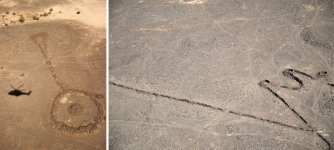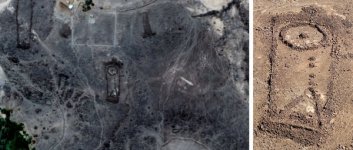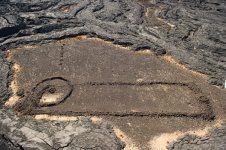David Baxter PhD
Late Founder
A Close-Up on Mysteries Made of Stone in Saudi Arabia’s Desert
by NICHOLAS ST. FLEUR, New York Times
November 17, 2017

A group of 19 "keyholes" at Al Wadi, in the Saudi Arabian desert, observed by
archaeologist David Kennedy from a helicopter. Dr. Kennedy took more than 6,000 aerial
photographs of these mysterious, ancient structures. (David Kennedy)
For nearly a decade, David Kennedy marveled from behind his computer screen at thousands of mysterious stone structures scattered across Saudi Arabia’s desert. With Google Earth’s satellite imagery at his fingertips, the archaeologist peeked at burial sites and other so-called Works of the Old Men, created by nomadic tribes thousands of years ago.
But he was unable to secure permission to visit the country to observe up close the ancient designs that he and amateur archaeologists had studied from their desktops. Last month, after announcing he had identified nearly 400 stone “gates,” Dr. Kennedy received the invitation of a lifetime from Saudi officials to investigate the hidden structures from a helicopter.
“They are absolutely astonishing,” said Dr. Kennedy, who recently retired from the University of Western Australia. “From 500 feet, you can see the vital details of structures that are invisible in the fuzzy image on Google Earth.” Over the course of three days, he snapped more than 6,000 aerial photographs, lifting the veil on the ancient wonders.

"Gates" at Samhah, which are more than 1,200 feet long. (David Kennedy)
Since 1997, Dr. Kennedy has studied similar structures in neighboring Jordan from the ground and sky. Many of the stone figures in both countries are in basalt fields known as harrats. The fields often feature dried up lava streams that twist and turn like slithering snakes across the dark landscape.
In Saudi Arabia, he explored 200 sites from the air across the regions of Harrat Khaybar and Harrat Uwayrid. The structures he observed ranged in shapes and sizes, which he describes as gates, kites, triangles, bull’s eyes and keyholes.
Of the 400 structures he describes as “gates” that he had identified on Google Earth, Dr. Kennedy studied about 40 from the helicopter and found that the structures were not randomly put together.

Gates with a "bull's eye." (David Kennedy)
“We could see immediately they were much more complicated than they appeared on Google Earth,” Dr. Kennedy said. They were not simply heaps of stone. Rather, each long bar was actually made up of two parallel lines of flat slabs placed on their edges facing each other with small stones filling the space in between. “They are much more sophisticated than I was prepared for,” he said.
Some gates were larger than 1,000 feet long and 250 feet wide. He suspected the oldest may be about 9,000 years old. Though he is not sure of their purpose, he speculated they may have been used for farming purposes.

A "kite" structure in the Harrat Khaybar region. (David Kennedy)
Dr. Kennedy also got a closer look at about a dozen of the “kites” that were first discovered in the Middle East by pilots in the 1920s. These are the most famous of the Works of the Old Men, and Dr. Kennedy has identified more than 900 of them in Saudi Arabia’s Harrat Khaybar.
From above, they typically resemble kites with strings and tails. They are often very large, with many stretching more than a quarter-mile. Archaeologists think gazelle were corralled into the head of the kite, where the hunters would come out to kill them. Sometimes multiple kites would overlap, so that if the animals got past one funnel they would get caught in another. “Essentially there was no escape,” said Dr. Kennedy.
The ones in Saudi Arabia looked as if they were better built than the ones in Jordan, according to Dr. Kennedy.

Left, Dr. Kennedy's helicopter casting a shadow near a bullseye. Right, a Khaybar kite.
(David Kennedy)
The harrats were littered with the smaller structures he has named keyholes, wheels, triangles and bull’s-eyes. Dr. Kennedy said he was surprised at how straight the lines of the triangles and keyholes were, as if the people who made them had picked out specific flat stones rather than random rocks. Each triangle was isosceles and looked like it was pointing at something. Sometimes they were directed to a bull’s-eye that was about 15 feet or 150 feet away.
There were also several keyhole structures, sometimes lined up together. The heads of the keyholes were almost always near-perfect circles, and the walls were about three feet high.
These structures may have served some funerary or symbolic purpose. Dr. Kennedy did not date any of the structures he visited with radiocarbon testing, but he said that future groups should perform more thorough analysis. “It’s absolutely vital that somebody follows up with serious groundwork,” he said.

Keyhole pendants. (David Kennedy)
Dr. Kennedy was invited by Amr AlMadani, the chief executive officer of the Royal Commission for Al-Ula Province, which was created to safeguard some of the country’s geological, historical and archaeological sites.
“Dr. Kennedy has spent many years poring over Google Earth images, and we were able to get him much closer to the sites,” said Mr. AlMadani, who joined Dr. Kennedy in the helicopter and described the experience as exciting.
“Thinking about how life was in the Arabian Peninsula and trying to imagine the way people hunted, lived and buried the dead was very much enriching,” he wrote in an email.

A bull's eye and triangle formation at Samhah as it's seen from Google Earth, left, and
photographed by Dr. Kennedy, right.
“Seeing it on Google images is one thing, but seeing it from a helicopter window from 300 feet is a totally different thing,” said Don Boyer, who accompanied Dr. Kennedy.
At the age of 70, Mr. Boyer is completing his doctorate in geoarchaeology and hydrology. “I think I was on a high the whole time. It was just remarkable. You run out of adjectives.”

A gate overlain with a bullseye pendant, surrounded by lava rock. (David Kennedy)
Read more..
by NICHOLAS ST. FLEUR, New York Times
November 17, 2017

A group of 19 "keyholes" at Al Wadi, in the Saudi Arabian desert, observed by
archaeologist David Kennedy from a helicopter. Dr. Kennedy took more than 6,000 aerial
photographs of these mysterious, ancient structures. (David Kennedy)
For nearly a decade, David Kennedy marveled from behind his computer screen at thousands of mysterious stone structures scattered across Saudi Arabia’s desert. With Google Earth’s satellite imagery at his fingertips, the archaeologist peeked at burial sites and other so-called Works of the Old Men, created by nomadic tribes thousands of years ago.
But he was unable to secure permission to visit the country to observe up close the ancient designs that he and amateur archaeologists had studied from their desktops. Last month, after announcing he had identified nearly 400 stone “gates,” Dr. Kennedy received the invitation of a lifetime from Saudi officials to investigate the hidden structures from a helicopter.
“They are absolutely astonishing,” said Dr. Kennedy, who recently retired from the University of Western Australia. “From 500 feet, you can see the vital details of structures that are invisible in the fuzzy image on Google Earth.” Over the course of three days, he snapped more than 6,000 aerial photographs, lifting the veil on the ancient wonders.

"Gates" at Samhah, which are more than 1,200 feet long. (David Kennedy)
Since 1997, Dr. Kennedy has studied similar structures in neighboring Jordan from the ground and sky. Many of the stone figures in both countries are in basalt fields known as harrats. The fields often feature dried up lava streams that twist and turn like slithering snakes across the dark landscape.
In Saudi Arabia, he explored 200 sites from the air across the regions of Harrat Khaybar and Harrat Uwayrid. The structures he observed ranged in shapes and sizes, which he describes as gates, kites, triangles, bull’s eyes and keyholes.
Of the 400 structures he describes as “gates” that he had identified on Google Earth, Dr. Kennedy studied about 40 from the helicopter and found that the structures were not randomly put together.

Gates with a "bull's eye." (David Kennedy)
“We could see immediately they were much more complicated than they appeared on Google Earth,” Dr. Kennedy said. They were not simply heaps of stone. Rather, each long bar was actually made up of two parallel lines of flat slabs placed on their edges facing each other with small stones filling the space in between. “They are much more sophisticated than I was prepared for,” he said.
Some gates were larger than 1,000 feet long and 250 feet wide. He suspected the oldest may be about 9,000 years old. Though he is not sure of their purpose, he speculated they may have been used for farming purposes.

A "kite" structure in the Harrat Khaybar region. (David Kennedy)
Dr. Kennedy also got a closer look at about a dozen of the “kites” that were first discovered in the Middle East by pilots in the 1920s. These are the most famous of the Works of the Old Men, and Dr. Kennedy has identified more than 900 of them in Saudi Arabia’s Harrat Khaybar.
From above, they typically resemble kites with strings and tails. They are often very large, with many stretching more than a quarter-mile. Archaeologists think gazelle were corralled into the head of the kite, where the hunters would come out to kill them. Sometimes multiple kites would overlap, so that if the animals got past one funnel they would get caught in another. “Essentially there was no escape,” said Dr. Kennedy.
The ones in Saudi Arabia looked as if they were better built than the ones in Jordan, according to Dr. Kennedy.

Left, Dr. Kennedy's helicopter casting a shadow near a bullseye. Right, a Khaybar kite.
(David Kennedy)
The harrats were littered with the smaller structures he has named keyholes, wheels, triangles and bull’s-eyes. Dr. Kennedy said he was surprised at how straight the lines of the triangles and keyholes were, as if the people who made them had picked out specific flat stones rather than random rocks. Each triangle was isosceles and looked like it was pointing at something. Sometimes they were directed to a bull’s-eye that was about 15 feet or 150 feet away.
There were also several keyhole structures, sometimes lined up together. The heads of the keyholes were almost always near-perfect circles, and the walls were about three feet high.
These structures may have served some funerary or symbolic purpose. Dr. Kennedy did not date any of the structures he visited with radiocarbon testing, but he said that future groups should perform more thorough analysis. “It’s absolutely vital that somebody follows up with serious groundwork,” he said.

Keyhole pendants. (David Kennedy)
Dr. Kennedy was invited by Amr AlMadani, the chief executive officer of the Royal Commission for Al-Ula Province, which was created to safeguard some of the country’s geological, historical and archaeological sites.
“Dr. Kennedy has spent many years poring over Google Earth images, and we were able to get him much closer to the sites,” said Mr. AlMadani, who joined Dr. Kennedy in the helicopter and described the experience as exciting.
“Thinking about how life was in the Arabian Peninsula and trying to imagine the way people hunted, lived and buried the dead was very much enriching,” he wrote in an email.

A bull's eye and triangle formation at Samhah as it's seen from Google Earth, left, and
photographed by Dr. Kennedy, right.
“Seeing it on Google images is one thing, but seeing it from a helicopter window from 300 feet is a totally different thing,” said Don Boyer, who accompanied Dr. Kennedy.
At the age of 70, Mr. Boyer is completing his doctorate in geoarchaeology and hydrology. “I think I was on a high the whole time. It was just remarkable. You run out of adjectives.”

A gate overlain with a bullseye pendant, surrounded by lava rock. (David Kennedy)
Read more..
